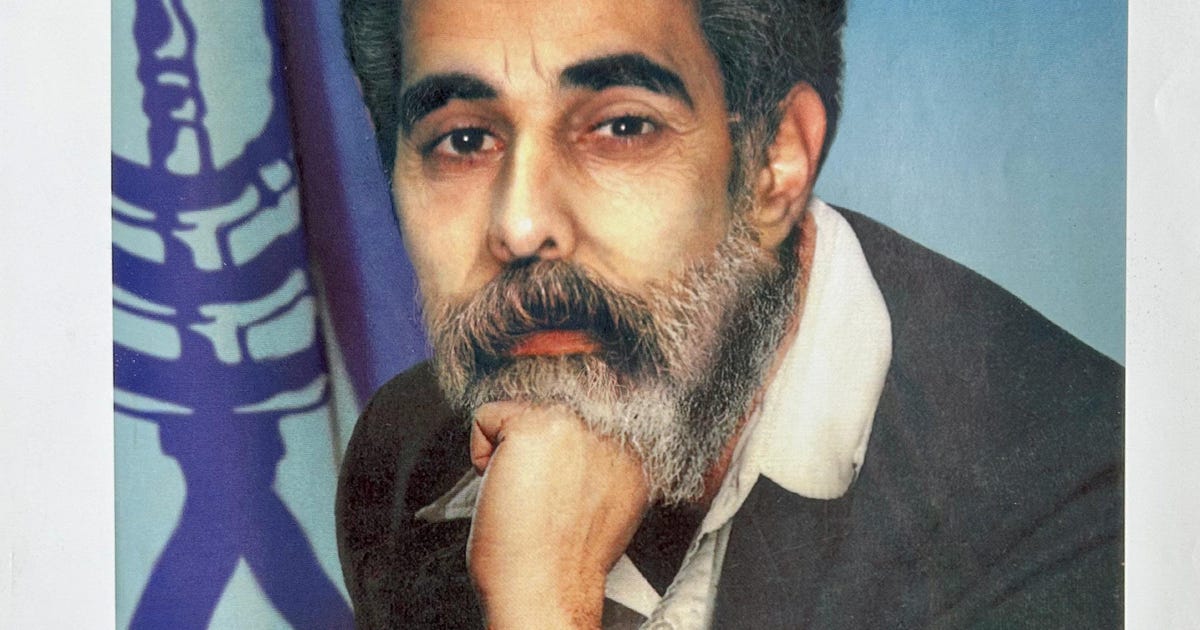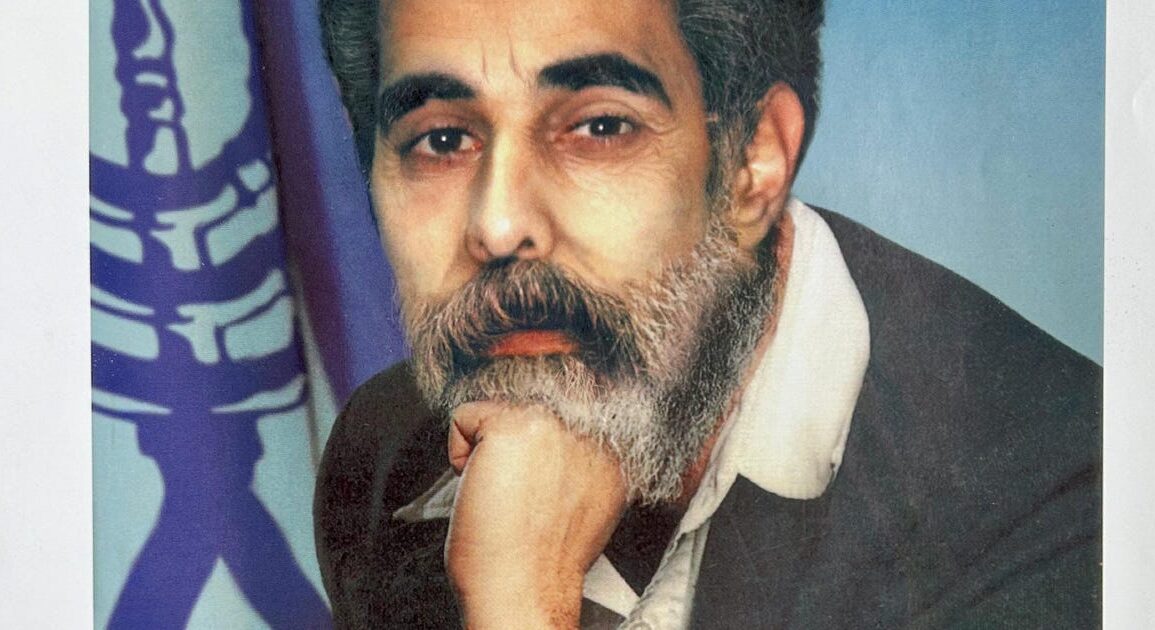
Like so many Israelis, artist Asi Burak was deeply disturbed by the assassination of Prime Minister Yitzhak Rabin in November 1995. His solution a few years later: Tell a story about Israel in 2023 that a quarter-century on seems remarkably prescient.
It all started a year after the murder when Burak, then a visual communication student at Jerusalem’s Bezalel Academy of Arts and Design, designed an action figure in the form of Rabin’s assassin, Yigal Amir. The doll was equipped with a Book of Psalms, a 9mm handgun and a police vest.
In 1998, Burak decided that his final project would expand on the doll idea. He imagined a nightmare scenario for 25 years later: His Israel of 2023 is divided into two states – Israel and Judea.
The State of Judea is headed by Amir, who obtained power while still in prison. Members of the Judean military wing, the Judean Front, bombed the Dimona nuclear reactor, took it over and threatened to use a doomsday weapon.
Visitors to Burak’s exhibit heard the national anthem as they walked in. On the wall hung a poster of the leader surrounded by slogans like “For the Cleansing of the Homeland” and flags emblazoned with a Star of David and a menorah. The project included a model of the Dimona reactor after it was bombed, a knitted kippa next to a Book of Psalms, and a protective vest with a pin showing the Third Temple.
The project drew its share of attention and was featured on the “Ulpan Shishi” current events program. Correspondent Rina Matsliah went with lawmakers Uzi Baram of Labor and Benny Eilon of the far-right Moledet party to the exhibit, where they discussed Burak’s frightening vision.
“Yesterday’s nightmare connects to tomorrow’s nightmare,” Matsliah says at the start of the segment, which has now gone viral online.
Burak, who lives in New York, is a senior executive at a computer game company and the man behind two successful video games: PeaceMaker, which hinges on a two-state solution to the Israeli-Palestinian conflict, and Half the Sky, which is designed to promote women’s rights in Africa and Asia. He’s also CEO of the nonprofit group Games for Change that promotes social change through video games.
In January this year, the month that may have launched the realization of Burak’s prophecy, the artist was in Israel and attended the first protests against the hard-right government’s judicial overhaul plan.
“When I came to Israel, it suddenly hit me that this is the year – and just then the video started going crazy on the internet too,” Burak says in a video call from New York. “It’s a very ambivalent feeling. On the one hand, suddenly a student project I did has all this meaning and impact, but on the other hand, I wish I’d been completely wrong. My whole family is in Israel. People are very worried. It’s very intense.”
What was the feeling like in Jerusalem after the Rabin assassination?
“I remember that we stood in line to pass the coffin at the Knesset. People made a pilgrimage to it. On the other hand, I saw how time eroded the power of the assassination. On the second anniversary of the murder, I saw that posters about it were put up in Jerusalem, and then people pasted posters of Meir Kahane over them. Just two years later.
“I was also very disturbed by all the talk about how the assassination was an outlier incident and the murderer was just a rotten apple. There was no addressing the fact that a system pushed him toward it. There was no real acceptance of responsibility.”
Burak presented his idea for the project to Prof. Shimon Sandhaus, who with legendary Israeli graphic designer David Tartakover supported and encouraged the fledgling artist. “They both believed in conveying social and political messages through art,” Burak says.
“At the time, students in the graphic design department were making things that could have been found anywhere in the world – pure design that had no connection to the place where it was created. When I promised my ‘Israel 2023’ project to Sandhaus, he told me right away that I should meet with people from across the political spectrum.”
Burak met with politicians like Likud’s Dan Meridor and Labor’s Lova Eliav, Yossi Beilin and Shimon Peres. He asked them the same question: What will Israel look like in 2023?
“As best as I can remember, Peres had a positive outlook – regional cooperation, a new Middle East. He spoke about peace agreements and explained that the economic interests of Israel and some of the Arab states would lead to relations,” Burak says.
“I remember telling Beilin that I was thinking about a nightmare scenario, and this really disturbed him. He said, ‘Why not do something positive – that 25 years from now there will be a Temple and a mosque side by side on the Temple Mount and everybody will live in peace?’”
Burak took inspiration from the symbols of the pre-state militias the Irgun and the Haganah, from messianic groups working to build a Third Temple, and from Hezbollah in Lebanon. “Every side has the same language for these things,” he says.
A key motif in the work is the black and yellow, the colors of Kahane’s far-right Kach movement, which had been outlawed. Burak even got to meet Itamar Ben-Gvir, now Israel’s far-right national security minister and then Kach’s youth coordinator.
“We met on the pedestrian zone in Jerusalem and he gave me leaflets for their summer camps,” Burak says. “After the segment aired on ‘Ulpan Shishi,’ he called me and said he saw the report and really enjoyed it. Then he asked for the leaflets back. I mailed them back to him right away.”
How did Ben-Gvir envision Israel in 2023?
“I don’t remember, but I think the stuff he gave me implied that he was setting up a youth underground. In the research, I came upon the existing concept of a State of Judea – an idea of a new myth that conquers the old myth. The Zionist myth was murdered by the old myth, and Yigal Amir is the rebellious son who kills his father. In the project, the nuclear reactor was the basis of the power of the old myth, instead of the Temple.”
Not too shocking
Burak’s project caused a stir across the political spectrum – but only to a point. “The work was pretty extreme even then, but not extreme enough to really upset people,” he says. “The Yigal Amir doll shocked people, but the shock wore off after a while.
“In the case of ‘Israel 2023,’ the result was the opposite. At the time, no one was taken aback too much by the scenario – though to most people it looked like it came from ‘somebody very leftist,’ as Benny Eilon said about me in the report. Now that the segment has been posted on Facebook, there have been reactions saying that both the project and people on the left are totally detached, or that the work is a piece of incitement.”
It’s not hard to guess how a work like “Israel 2023” would be received today. In March, when artist Ido Gordon’s wall clock with hands forming a crucifix was shown in Tel Aviv, it set off violent reactions online.
Then there was the episode at the Ramat Gan Museum of Israeli Art, which under pressure from the mayor removed David Reeb’s work “Jerusalem of Shit.” And the Jerusalem municipality refused to display a painting by Sara Benninga that included nudity. So it’s clear thata decision to censor art goes way beyond ideology, that it’s a tool in the political game.
Maybe the work enjoyed legitimacy precisely because it came so soon after the Rabin assassination.
“Exactly, but it was also perceived as totally far-fetched. The right thought it was paranoid. My project ends with a big explosion between Israel and Judea. It reaches the most extreme place, and there’s no solution.”
Some might say that your vision is coming true – that the settler riot and arson attack on the Palestinian town of Hawara in February wasn’t a one-off event.
“Definitely. In my scenario, the new myth takes over by force. When you think about it, Ben-Gvir basically came from the fringes of the law – the army wouldn’t draft him, and now all of a sudden he’s a minister in the Israeli government, part of the mainstream. Some might say that what’s happening now is worse than my scenario because the mainstream has been taken over by the messianic stream.
“It’s very hard to fight extremists who are motivated by such a strong ideology. … They’re very devout and have no doubts. These are the people who brought about the destruction of the Temple, the zealots who refused to heed the warnings. Today they’re playing on the political field and exploiting legal means to achieve their goals. I believe they could break the law. They did in the past.”Do you find yourself wondering what could happen here in the next 25 years?
“I’ve been asked about 2048. A lot of people foresee disaster, the destruction of the Third Temple. I think that a state can survive for a long time as a bunker state like North Korea or Russia. The inhabitants of this state won’t have a good quality of life.
“Another possibility is that relations with more countries will thaw, a sane center will take steps, and there will be a peace agreement or some sort of solution with the Palestinians. That would be a better country to live in. The sane center has the capacity to stop the extremists. The problem is that the current debate doesn’t support things going in this direction too much.”
So you’re not optimistic?
“I’m not very optimistic because of the demographics that are going in the opposite direction from the sane center. The people in the liberal camp realize that even if they become a minority they’ll continue to serve in the army, pay taxes and carry the burden – but there’s a limit to what they’ll take on.”
Click the alert icon to follow topics:
This post was originally published on this site be sure to check out more of their content.







